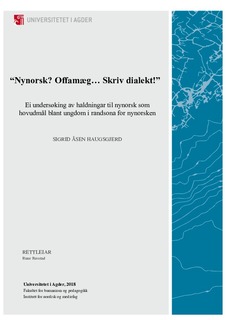| dc.description.abstract | In this quantitative study I have researched language attitudes among students in
lower secondary school at the border line of the Nynorsk area. All students in this
research has Nynorsk as their written language, but attends a school where there are
equally amount of students who write Bokmål and who write Nynorsk. Evje and
Hornnes municipality is itself language neutral, and is located in an area surrounded
by both neutral, Bokmål and Nynorsk municipalities.
To properly research the language attitudes towards Nynorsk among youth in this
area, I have completed a quantitative research in two classes in lower secondary
school. The research consists of a semi-structured questionnaire consisting of both
closed and open questions to answer the research question. The main objective of this
research is to find out: “Which language attitudes towards Nynorsk as a main
language do lower secondary school students in a municipality in the border line of
Nynorsk have?”
Results of this research are presented thematically in the subthemes Relationship
towards Nynorsk, Practical use of Nynorsk, Bokmål and dialect and The future of the
users of Nynorsk.
Results show that the youth which have Nynorsk as their main language consider the
language primarily a school language. They see Nynorsk as old-fashioned and
unnatural, and many react when they read Nynorsk in social media. Some reacts in a
negative fashion, others positive, but this shows that the language is considered more
marked than Bokmål. Many of them do not wish for Nynorsk language to be present
in more areas in society, however they think that those who write Nynorsk should be
able to do it everywhere. They do not write Nynorsk much outside school. The
language is not seen as an important part of their daily lives, and therefore they do not
consider Nynorsk as a part of their identity. There are a positive attitude towards
dialects, and especially towards the local dialect. Outside school, most of the youth
writes in dialect, or a mixture of Bokmål and dialect. I discuss how the future looks
for Nynorsk in this area, considering the relationship between language attitudes and
how this affects language change from Nynorsk to Bokmål. | nb_NO |

